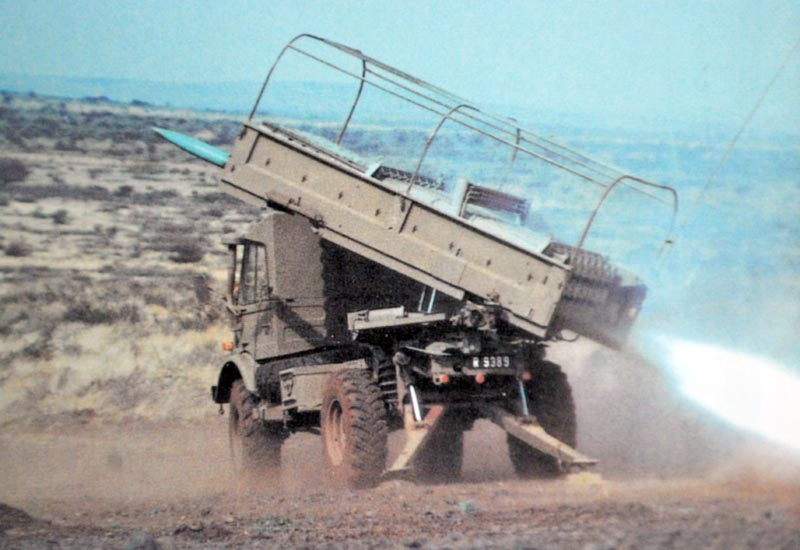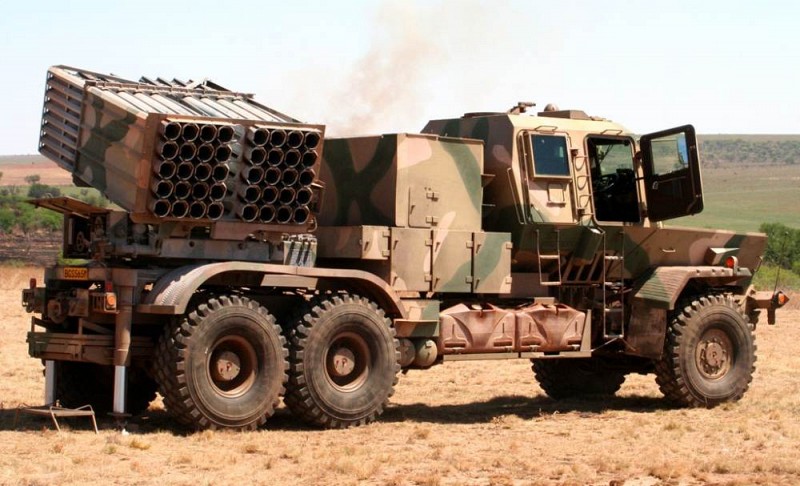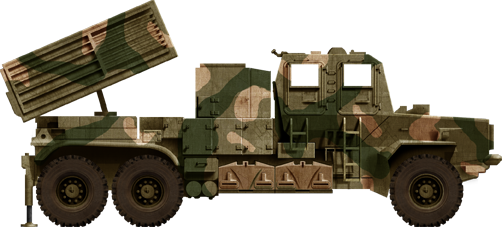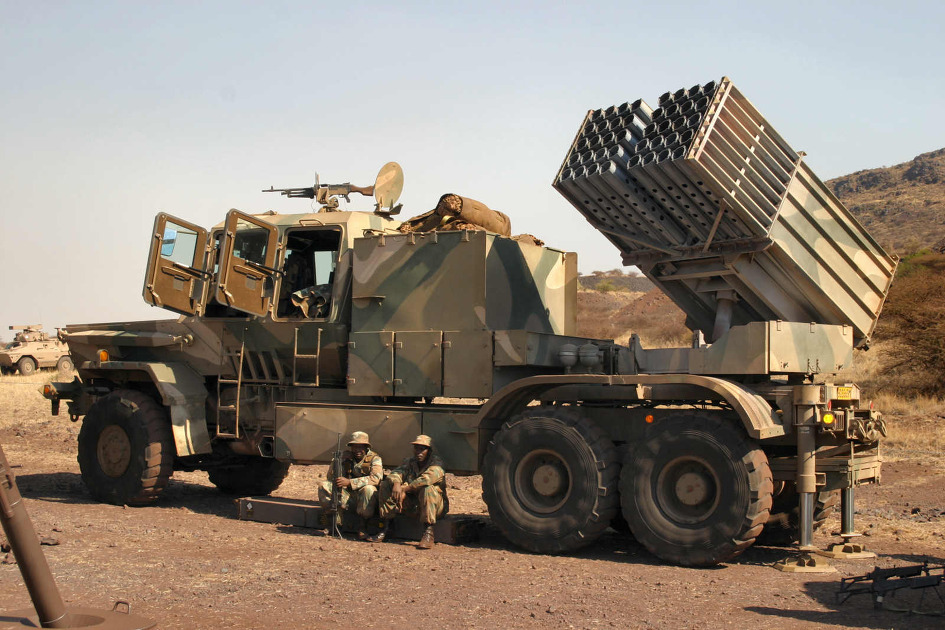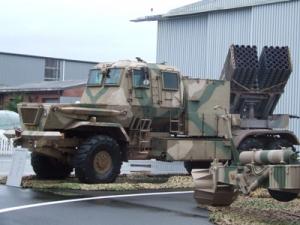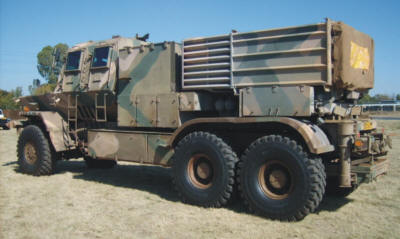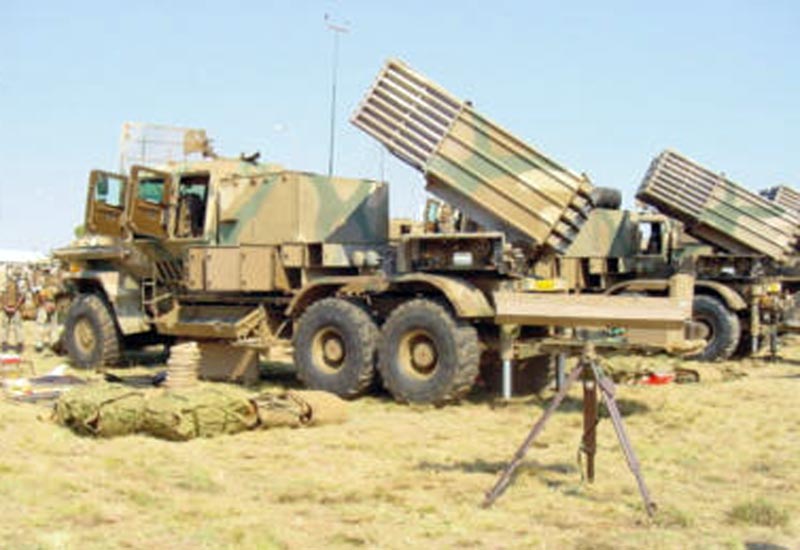Overview of SANDF MRLs
MRLs (Multiple Rocket Launcher) are nowadays a staple of artillery outside standard cannons and howitzers. Most armies possessed some, generally using simple trucks as carriers. Several types of vehicles classed as MLRs were designed and used by SANDF, motivated by the experience of the Namibian border war. According to the International Institute for Strategic Studies (IISS), SANDF MLRS programme (Project Furrow) started in 1974. The first model to be born of this process was the Valkiri-22 Mk 1 (also called Visarend VT-1), a simple conversion of the standard Unimog 4×4 chassis, with the rear bay converted to carry a 24 launch tubes rack.
The more recent Valkiri 5 was an even shorter, lighter version designed for the airborne and carrying half the payload with a 12-tubes rack. The rockets were also shorter, with a 5500 m max range. The third and most recent is the Bateleur built by Denel on a Samil 100 6×6 truck chassis, which is much better protected against mines and small arms fire. So far no Bateleur has fired a short in anger, and it is only used by the SA Army Artillery School, Artillery Mobilization Regiment and 4th Artillery Regiment in Potchefstroom, the Potchefstroomse Universiteit Regiment, and the Transvaalse Staatsartillerie of Pretoria.
Development of the Bateleur
The Bateleur (after a local sub-Saharan bird of prey) is nowadays the standard MLRS of the South African Artillery, with 25 in service. It originated in a Rheinmetall Denel Munitions (RDM) 453 601.60 contract for the procurement of the Bateleur upper structure. Its development started in the 1980s by the Council for Scientific and Industrial Research (CSIR), helped by Denel Dynamics and RDM Western Cape. The process ended in 1986 and it was eventually pressed into service in 1989. It seems nowadays that only the Bateleur is left into active service.
Design
The Samil 100 truck chassis is based on the standard 6×6 Samil 100 itself derived from the Samil 50, a Magirus-Deutz 4×4 design and standard SANDF military truck. The rear double axle is necessary to support the weight of a much larger 40 tubes rack and its support, plus the auxiliary power unit and reload system. The armored crew cab (four doors, for the driver, commander and 3 operators on the rear bank) is protected against small arms fire, artillery shell splinters and land mines thanks to a V-shape belly (as the engine itself). Its Deutz F10L 413F diesel engine is developing 315 horsepower, for a top speed of 75 kph and a range of about 1000 km. Supply is assured by a following Kwêvoël 100 ammunition truck carrying 96 rockets and personal helping the reloading process.
Armament
The rocket pack can traverse 360° and had elevation (max 60°?) and is arranged in two 5×4 tubes, each housing a 127 mm rocket (5 in), 2.95 m long and weighting 62 kg. Each rocket can be equipped with either HE-FRAG (Frag submunitions, anti-tank or anti-personnel mines) and cluster ammunitions, or the older model used on the Valkiri. The caliber was also chosen because of its launcher tube compatibility with the local Kentron V3 air-to-air missile. Firing range is 8 to 36 km, and a salvo lasts for 46 s on average with a reloading time of 15 to 20 minutes. Each HE-Frag warhead counts 6400 steel balls cast in a resin sleeve, filled with RDX/TNT mix, detonated with direct action or proximity fuses.
Links/sources
defenceweb.co.za
warwheels.net
nairaland.com
Bateleur FV2 specifications |
|
| Dimensions | 8.54m x 2.42m x 3.12m (H,W,L) |
| Total weight, battle ready | 21.5 tons |
| Crew | 5 (driver, cdr, 3 operators) |
| Propulsion | V10 15.95 litre air-cooled 4-stroke direct injection diesel generating 268hp @ 2650rpm. |
| Suspension | 6×6 coil springs |
| Speed (road) | 90km/h (56 mph) |
| Range | 1000 km (600 mi) |
| Armament | 40 x 127 mm rocket |
| Armor | STANAG 4569 level 2 |
| Total production | 25 in 1989 |

Cold War Tanks


































Cold war tanks posters

Cold War Main Battle Tanks

Cold War Soviet Army
Museums, Movies, Books & Games
The Tanks and Armor in pop culture
Tanks and armored vehicles in general are only really grasped when seen first person: The mass, the scale, it's all there. Explore also the way tanks were covered in the movie industry, in books and in video games.Movies:
Best tanks movie on warhistoryonline.com
On imdb.com
On bestsimilar.com/
miltours.com
liveabout.com/
watchmojo.com
Video Games:
pcgamesn.com
historyhit.com
levvvel.com
vg247.com/best-tank-games
mmobomb.com/
alienwarearena.com


